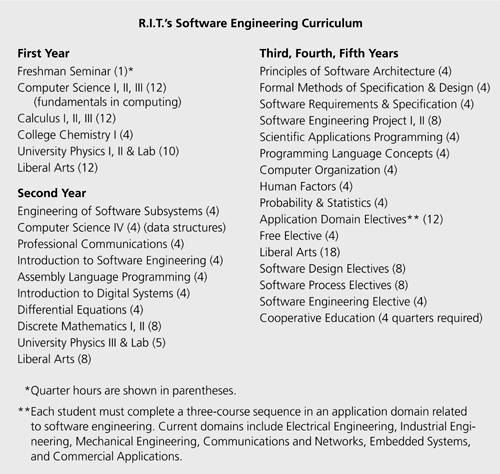First Steps
| Graduate-level programs in software engineering have existed for about 20 years, but undergraduate programs are still in their infancy, especially in North America. Seattle University awarded the world's first software engineering master's degree in 1982. The Department of Computer Science at the University of Sheffield in the United Kingdom introduced an undergraduate degree program in software engineering in 1988. Rochester Institute of Technology (R.I.T.) initiated the first undergraduate software engineering program in the United States, admitting freshmen in 1996 and graduating its first class in 2001. At present, about 25 software engineering master's programs are offered in the United States. A handful are offered in Canada, the United Kingdom, Australia, and other countries.[6] As of summer 2003, about two dozen universities offer undergraduate software engineering degrees in the United States and Canada. At least 13 universities offer undergraduate programs in the United Kingdom and at least 6 more offer them in Australia. R.I.T. and other universities have been working with the IEEE Computer Society, the ACM, and ABET/EAC (Engineering Accreditation Commission) to develop programs that can be accredited as engineering programs in the United States. Figure 18-3 shows an example of the courses required in R.I.T.'s program. Figure 18-3. R.I.T.'s undergraduate software engineering program requires courses in computer science, communications, liberal arts, and software engineering.
R.I.T.'s program contains some courses from the computer science department (for example Computer Science I, I, III, and IV). It also contains several courses that you wouldn't normally find in a computer science program, including Engineering of Software Subsystems, Software Requirements & Specification, Software Engineering Project I and II, and Human Factors. It also requires four quarters of cooperative education and significant experience working in teams in other words, a student must obtain significant experience with industrial practice before earning a degree. This sort of experience requirement is a hallmark of an engineering program. Computer science programs can require industry experience, but only at the expense of diluting their emphasis on pure science. One interesting aspect of R.I.T.'s program is its length five years. During the mid-1900s, engineering undergraduate degrees were usually five-year programs.[7] Later, various pressures led universities to shorten their programs to four years. Teaching software engineering as an undergraduate degree in four years may be impractical, especially using the R.I.T. model in which students spend a year gaining experience in industry. Five-year programs may become the norm for undergraduate software engineering. |
EAN: N/A
Pages: 164
